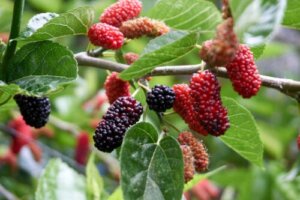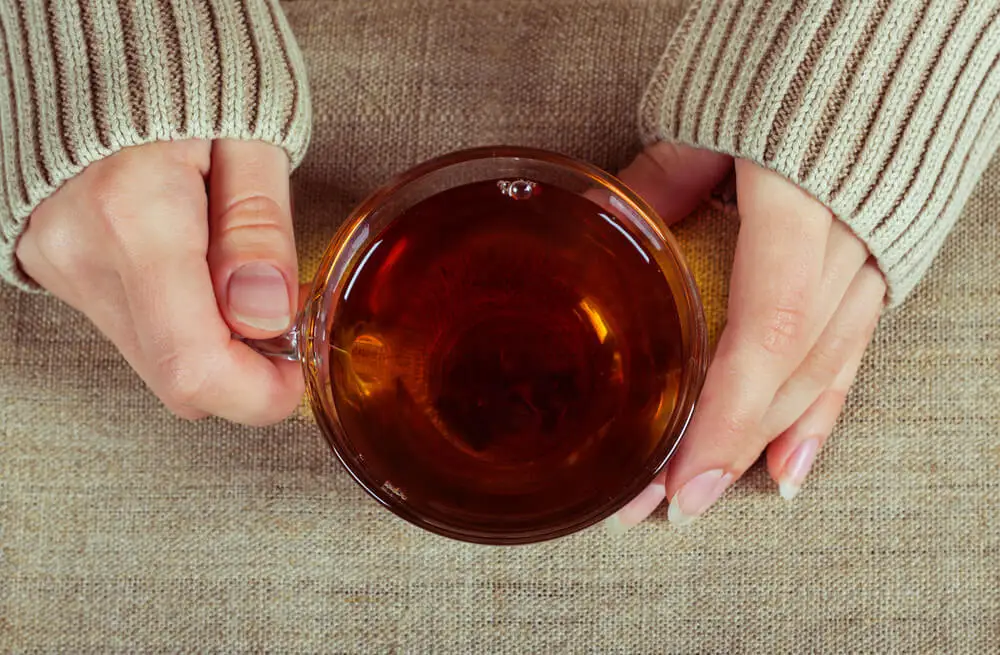White Mulberry: What Are Its Benefits?


Reviewed and approved by the pharmacist Franciele Rohor de Souza
The white mulberry, with the scientific name Morus alba, is a tree that belongs to the Moraceae family. It’s native to China, but its cultivation also extends to Iran, Turkey, Austria, Mexico and the United States. Medicinally, its leaves, root, bark and fruit are used.
In particular, it’s often used for its laxative, antiseptic, antidiabetic and antihyperlipidemic properties through oral supplements such as teas, powders, and tablets. It stands out for its abundant content of anthocyanins, in addition to vitamins, minerals, and other pharmacological compounds.
Although it has multiple applications in complementary medicine, many are still controversial. For now, only some scientific studies speak of its effects against certain metabolic disorders and dental problems.
Do you want to know more about it? Don’t miss this article!
Uses and benefits of white mulberry
All parts of the white mulberry are usually used, due to its phytochemical content. As detailed in a publication in Foods magazine, the leaves, fruits and seeds are a source of bioactive compounds:
- Protein
- Fiber
- Carbohydrates
- Phenolic acids
- Flavonoids
- Flavonols
- Anthocyanins
- Vitamins (especially vitamins C and A)
- Minerals (calcium, potassium, magnesium, zinc, among others)
Read also: What Is Cyanidin and What Is It Used For?
This composition is linked to a series of positive health effects. Anecdotal evidence suggests that it serves as an adjuvant in cases of flu, colds, coughs, and sore throats. In addition, it’s believed to improve symptoms of arthritis and other joint disorders.
However, at this time there hasn’t been sufficient research to substantiate its effects.
Because of this, its use as an herbal supplement should be merely complementary. For no reason should it replace the treatments prescribed by the doctor nor should it be a therapeutic option of first choice.
Let’s take a look in detail at its main benefits and what science says about it.
Postprandial glucose control
Due to its abundant anthocyanin content, white mulberry is used as an adjuvant to regulate high glucose levels. It is believed to benefit the health of patients with prediabetes and type 2 diabetes.
In a systematic review reported in Evidence-Based Complementary and Alternative Medicine, researchers determined that white mulberry may lower postprandial, i.e., post-meal, glucose and insulin levels. One hypothesis suggests that the active compounds in mulberry leaves stimulate insulin secretion in the pancreas and reduce glucagon synthesis, resulting in more stable glucose levels.
Still, experts believe that there’s insufficient evidence to be sure that mulberry effectively lowers blood glucose. Therefore, they stress the need for larger studies.

Lowering cholesterol levels
The antihyperlipidemic properties of white mulberry are highlighted in complementary medicine for its heart health benefits. The leaves, seeds, roots and fruits all contain antioxidants that promote the lowering of blood cholesterol.
In this regard, a small study shared in Phytotherapy Research reported that a white mulberry leaf extract, administered 3 times daily before meals, was helpful in lowering total cholesterol, LDL or bad cholesterol and triglyceride levels in 23 adults with dyslipidemia.
The plant’s abundant content of anthocyanins, flavonoids and phenolic acids may be behind this effect. However, more studies are needed.
Prevention of dental problems
The antimicrobial potential of white mulberry is used as a complement to take care of dental health. In a study shared in the International Journal of Pharma and Bio Sciences, it’s stated that the root extract can combat oral pathogens associated with gum disease.
To be more precise, it was observed that it can act on microorganisms such as Streptococcus mutans, Lactobacillus acidophilus and Enterococcus faecalis . Thus, it’s linked to the prevention of diseases such as caries, gingivitis and periodontitis.
A compound known as kuwanon G -exclusive to this plant- would be responsible for this effect. Other research shared in the Journal of Ethnopharmacology suggests the same.
Skin protection
Phenols, flavonoids, terpenes and other antioxidant compounds in white mulberry are linked to skin protection. In particular, these substances aid in the prevention of premature aging and conditions such as hyperpigmentation.
In fact, research shared in the Journal of Agricultural and Food Chemistry suggests that Morus alba extracts help decrease DNA damage associated with skin cancer. More studies are needed to corroborate this.
Discover: Acai Berry Cleansing: Why Is It a Dangerous Trend?
Possible side effects of white mulberry
Given the lack of research, there isn’t much information on the safety of white mulberry. In small doses it is considered safe for most healthy adults.
Still, some people may experience side effects, such as diarrhea, dizziness or constipation when taken in high doses.
White mulberry supplements are not recommended for the following:
- Pregnant and breastfeeding women.
- Patients about to undergo surgery.
- People under treatment for high blood pressure.
- People with chronic diseases. If so, it’s essential to consult a doctor.
- People under treatment for diabetes. Simultaneous use with anti-diabetic drugs can lead to hypoglycemia, dizziness, fatigue and fainting.
Presentations and consumption of white mulberry
White mulberry is distributed as an oral supplement in tablets, dry powder, or tea bags. Each presentation may vary in terms of suggested dosage. Therefore, the product label should be consulted.
The powder is often combined with juices, yogurt, smoothies or milk. It’s available in extract form from the fruit, but also from the roots and leaves. The latter option has a slightly bitter taste.
Storage should be at room temperature, away from any sources of moisture. In cases of mold or signs of deterioration, it should be discarded.

What to remember about white mulberry?
All parts of the white mulberry are used for medicinal purposes, due to its abundant content of antioxidants and bioactive compounds. Even so, there aren’t enough scientific studies to corroborate the benefits attributed to it.
For now, its supplements should be used only for complementary purposes, preferably supervised by a physician. It may help to reduce glucose, high cholesterol, and some dental problems. However, more evidence is needed.
All cited sources were thoroughly reviewed by our team to ensure their quality, reliability, currency, and validity. The bibliography of this article was considered reliable and of academic or scientific accuracy.
- Chen C, Mohamad Razali UH, Saikim FH, Mahyudin A, Mohd Noor NQI. Morus alba L. Plant: Bioactive Compounds and Potential as a Functional Food Ingredient. Foods. 2021 Mar 23;10(3):689. doi: 10.3390/foods10030689. PMID: 33807100; PMCID: PMC8004891.
- Jeong, H. I., Jang, S., & Kim, K. H. (2022). Morus alba L. for Blood Sugar Management: A Systematic Review and Meta-Analysis. In F. Tonelli (Ed.), Evidence-Based Complementary and Alternative Medicine (Vol. 2022, pp. 1–10). Hindawi Limited. https://doi.org/10.1155/2022/9282154
-
Aramwit, P., Petcharat, K., & Supasyndh, O. (2010). Efficacy of mulberry leaf tablets in patients with mild dyslipidemia. In Phytotherapy Research (p. n/a-n/a). Wiley. https://doi.org/10.1002/ptr.3270
- Smitha, Chenicheri & Usha, Rajamanickam. (2016). Antimicrobial and antiplasmid activities of Morus Alba L. against potent oral pathogens. International Journal of Pharma and Bio Sciences. 7. 767-772.
- Park, K. M., You, J. S., Lee, H. Y., Baek, N. I., & Hwang, J. K. (2003). Kuwanon G: an antibacterial agent from the root bark of Morus alba against oral pathogens. In Journal of Ethnopharmacology (Vol. 84, Issues 2–3, pp. 181–185). Elsevier BV. https://doi.org/10.1016/s0378-8741(02)00318-5
-
Zheng, Y., Lee, E.-H., Lee, S.-Y., Lee, Y., Shin, K.-O., Park, K., & Kang, I.-J. (2023). Morus alba L. root decreases melanin synthesis via sphingosine-1-phosphate signaling in B16F10 cells. In Journal of Ethnopharmacology (Vol. 301, p. 115848). Elsevier BV. https://doi.org/10.1016/j.jep.2022.115848
- Woo H, Lee J, Park D, Jung E. Protective Effect of Mulberry (Morus alba L.) Extract against Benzo[a]pyrene Induced Skin Damage through Inhibition of Aryl Hydrocarbon Receptor Signaling. J Agric Food Chem. 2017 Dec 20;65(50):10925-10932. doi: 10.1021/acs.jafc.7b04044. Epub 2017 Dec 12. PMID: 29231728.
This text is provided for informational purposes only and does not replace consultation with a professional. If in doubt, consult your specialist.








